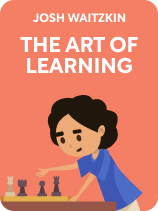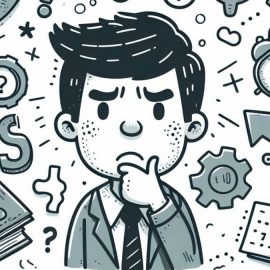

This article is an excerpt from the Shortform book guide to "The Art of Learning" by Josh Waitzkin. Shortform has the world's best summaries and analyses of books you should be reading.
Like this article? Sign up for a free trial here .
What is Josh Waitzkin’s book The Art of Learning about? What is the key message to take away from the book?
In his book The Art of Learning, Josh Waitzkin argues that a passionate commitment to learning leads to both competitive success and a fulfilling life. He explains what he learned in becoming the U.S. Junior Chess Champion as well as World Champion in Tai Chi Chuan Push Hands, arguing that excellence comes from unwavering focus, tenacious training, and creative self-actualization.
Here is a brief overview of The Art of Learning by Josh Waitzkin.
The Art of Learning
Josh Waitzkin is an International Master in chess and World Champion in Tai Chi Push Hands, the combative variant of tai chi. A chess prodigy, he began playing at the age of 6, drawn to the streetside boards set up by New York City park hustlers. Soon after, Bruce Pandolfini (a prominent chess coach) took Waitzkin on as a student, and he went on to win several national championships in his early teens. Waitzkin became a National Master at age 13 and an International Master at 16.
Waitzkin shifted away from chess in his late teens, as fame and coaching methods conflicted with his well-being. Soon after, he began to study tai chi under master William C. C. Chen, who later invited Waitzkin to study Push Hands. Through his twenties, he rose through the US tournament rankings and went on to win the World Championship in Taiwan in 2004.
In this book The Art of Learning, Waitzkin explains how he was able to rise to the top of two seemingly unrelated disciplines. In our guide, we’ll explain Waitzkin’s basic method and mindset, cover his intermediate techniques, and finish with his advanced strategies. In addition, we’ve consolidated Waitzkin’s repeated emphasis on “presence” into one section and compared his learning approach to perspectives from The Talent Code by Daniel Coyle, Black Box Thinking by Matthew Syed, and others.
Presence Underpins Real Skill
Waitzkin says that presence—which he defines as deep, focused calm—is essential for the mastery of any skill. In competition, your awareness becomes sharper, yet must remain calm and focused—like a samurai standing relaxed, yet intensely ready, when facing his opponent.
(Shortform note: Waitzkin’s emphasis on presence evokes Eckhart Tolle’s perspective in The Power of Now, where Tolle argues that living intensely “in the here and now” is the only path to true fulfillment. While the two approach life differently—Waitzkin with an intense, single-minded focus on learning and growth and Tolle with an emphasis on spiritual enlightenment—presence is key to both. In other words, that Waitzkin’s life is so different from Tolle’s, yet both center on presence, suggests that presence is a flexible tool for each individual to find and explore their own path toward fulfillment.)
Waitzkin gives two key reasons presence is important in life and competition:
Reason #1: Presence equips you to navigate the turbulence of life. In our unpredictable world, we need to navigate many obstacles to success, whether they’re external (like a noisy arena) or internal (like emotional turbulence).
Waitzkin says that a calm, present mind helps you handle physical, mental, and emotional turbulence by empowering you to embrace distraction and process your emotions.
(Shortform note: It’s helpful to think of Waitzkin’s notion of presence as mindfulness. Recent research supports his claim that presence is a key tool for emotional regulation. Practicing mindful presence develops your capacity for emotional nonreactivity—the capacity to experience your emotions without allowing them to dictate your behavior.)
Reason #2: Presence is the key to competitive success. Being present helps you focus on growing and allows you to regain perspective when you lose. Waitzkin recounts an early loss in his chess career that knocked him off balance. By separating himself from the game and focusing on presence, he was able to return refreshed and reinspired.
Waitzkin points out that when you compete at a high level, the margins are so slim that being a tiny bit more present than your opponent is a significant advantage. Presence helps you reach flow, or “the zone,” which can give you a leg up on your opponents.
(Shortform note: Mindfulness plays a huge role in modern athletic training. Athletes like Derek Jeter, Kobe Bryant, and tennis champ Bianca Andreescu (who defeated Serena Williams), all cite presence as key to their success. Amy Saltzmann, a mindfulness coach, suggests that mindfulness training could help amateur athletes to climb the ranks faster: Since mindfulness hasn’t fully permeated professional athletics, those who start practicing it while young can gain a mental and emotional advantage over their competition.)
Growth Comes From Trial and Error
Waitzkin explains that learning happens through trial and error. When you make mistakes, you have the opportunity to grow. One step at a time, you can reflect on errors to grow your skills.
For example, you can learn a guitar chord by trying to play it, adjusting your fingers based on what sounds wrong, and repeating until you reach the correct form.
(Shortform note: In Black Box Thinking, Matthew Syed argues that error is inherent in learning. Mistakes reveal the flaws in our skills and show us where to grow. As Syed shows, incremental growth is profoundly powerful: It’s the mechanism that drives evolution. Organisms and ecosystems evolve by undergoing continuous stress tests (storms, drought, predation, and so on) that select for the fittest creatures. So while “learn from your mistakes” might sound like a platitude, it’s profoundly useful.)
Each time you act, err, adjust, and repeat, you make an incremental improvement. Waitzkin says that to learn is to build increment on increment on increment. Each addition builds your knowledge, demonstrating that success comes from mistakes.
| How to Learn From Your Mistakes In Black Box Thinking, Syed gives a step-by-step process for how to learn from errors. The key is to set up a tight feedback loop between the steps you take and the lessons you learn: 1. Take action using your current knowledge. Start practicing that habit you’ve been thinking about (for example, beginning a daily 30-minute morning cardio session). 2. Observe how things go and gather data. You might keep a simple log in which to reflect daily on how you feel after your workout. 3. Note any mistakes and analyze what went wrong. Maybe you missed a day, and you notice it was because you were tired from staying up too late. 4. Use your data to make a simple, actionable change. Incorporate the feedback into your next action. In the above situation, you might adjust by turning your phone off at 9 p.m. to avoid late-night use. |
Focus On the Process
To improve through trial and error, you need to have a growth mindset. Waitzkin explores Carol Dweck’s research on “incremental” versus “entity” theories of intelligence. In Mindset (Dweck’s book on the topic) she refers to these as “growth” and “fixed” mindsets. Here, we’ll examine Waitzkin’s interpretation of the two mindsets as they relate to skill-building and competition.
With a growth mindset, you believe that you can develop your abilities through patient practice, building increment upon increment, and you see challenges as opportunities to stretch your current capacities.
(Shortform note: Angela Duckworth’s notion of Grit is closely related to the growth mindset. Duckworth argues that grit—a personality trait combining hard work, resilience, and perseverance—predicts success better than talent or luck, because those who drop out when the going gets tough won’t make it to the top even if they’re naturally talented. It’s worth noting that in addition to advocating for a growth mindset, Waitzkin himself possessed natural talent as a 6-year–old chess prodigy and skilled meta-learner.)
In contrast, those with a fixed mindset believe that ability is inherent and set in stone. Waitzkin warns that a fixed mindset is dangerous because it doesn’t prepare you for obstacles. Instead, people with fixed mindsets tend to give up when confronted with challenges that surpass their current abilities.
A fixed mindset focuses on outcomes over process, Waitzkin says. So competitors with a fixed mindset worry about whether they’ll succeed, rather than focusing on what they can learn. When you inevitably experience adversity, a fixed mindset will fall short—if you fixate on outcomes, you’re more likely to fall apart when you lose.
(Shortform note: Fixed mindsets aren’t necessarily fixed. In fact, one argument suggests that you can choose your mindset based on the given situation. Furthermore, in some instances, a fixed mindset is preferable. For example, assuming a fixed mindset is effective when you need to quickly complete a task, especially if it’s for the benefit of a group in a collaborative situation. In other cases, such as when you’re working on a solo project, you can switch to a growth mindset and focus on developing and improving your own skills.)
Rather than focusing on a desired outcome, Waitzkin recommends committing to the process of growth—to daily practice, focused patience, and adaptation in the face of obstacles. According to Waitzkin, this approach keeps you resilient, since you embrace failure as part of the journey and learn from it instead of fearing it.
(Shortform note: It’s worth noting that you don’t need to immediately learn from your failure, and it’s okay to feel strong emotions after a heartbreaking loss. Waitzkin acknowledges this by detailing how after losing an important youth tournament, he needed a few weeks away from the game to clear his mind and reset. You also don’t need to be an implacable growth robot: Leaning on family and friends can help you process your emotions and get back on your feet. In this way, close community is a valuable extension of your own mindset.)
Start With the Fundamentals
Waitzkin recommends starting with the fundamentals of your skill. Begin by studying the basic elements of your skill, one by one. Any skill is composed of simple, elemental chunks of know-how. For example, when learning to play basketball, you’d learn how to dribble, pass, shoot, and so on.
(Shortform note: In Fluent Forever, Gabriel Wyner explains that we should learn languages from the bottom up—starting with the sounds, moving to single words, then to grammatical patterns, and interspersing conversation practice to tie it all together. This is much like Waitzkin’s recommended approach: Practice one element at a time to build up your skill.)
Patiently practice each element until it becomes intuitive. Waitzkin calls this form to leave form: Through practice, a conscious effort becomes unconscious, or automatic. For example, if you drill 10,000 free throws, your form will eventually become second nature.
(Shortform note: Though Waitzkin doesn’t say it explicitly, this approach is much like deep practice. Deep practice is a way of learning that emphasizes patient, step-by-step refinement of one technique at a time.)
Once each element is intuitive, start combining them. Continue to practice until you can unconsciously coordinate multiple basic elements of your skill. For example, you might train in basketball techniques until you can stop on a dime, catch a bounce pass, dribble to the three-point line, and execute a free-throw.
(Shortform note: In The Talent Code, Daniel Coyle discusses how deep practice develops myelin more efficiently than unfocused practice. Myelin is a neural tissue that wraps around neurons or nerve cells, speeding and smoothing the signals that travel along those cells. The more myelin you’ve grown, the more automatically you can perform a practiced behavior. In other words, myelin makes your skills habit, or intuitive. This is the neuroscience of Waitzkin’s “form to leave form”: Dedicated practice of individual skills develops myelin, and well-myelinated skills feel like natural instinct.)
Develop Your Personal Style
In addition to achieving mastery, incremental skill-building also enables your unique style to emerge. When you intuitively understand the elements of a skill and their interrelationships, you can combine them in creative ways.
Waitzkin argues that we’re naturally drawn to particular skills. He doesn’t directly explain this, but we can infer that it’s a deep feeling, not conscious thought, that draws you in. For example, Waitzkin felt an intense resonance with chess from the first time he saw it played.
(Shortform note: While Waitzkin doesn’t explain how to find your personal style, you may already have a sense for it. Consider that you know what kind of music, food, clothing, and friends you like. Your taste suggests what you’re most drawn to, and it’s a good starting point for finding your style in a particular skill. Taste develops over time as we discover what we’re good at: As we get better at something, we tend to like it more, because we feel good about being able to process it fluently.)
Your personal style is how you instinctively approach the skill. For example, Waitzkin describes himself as having been a chaotic, rough-and-tumble kid—and his aggressive, attacking chess style reflected those traits.
According to Waitzkin, you must honor your personal style if you want to become truly great. That means developing your skill according to what most inspires you, so that you come to embody that skill as only you can.
Many famous athletes and musicians demonstrate this point—jazz trumpeter Louis Armstrong; Brazilian footballer Pelé; Olympians like Simone Biles and Serena Williams—each is known for their characteristic style.
(Shortform note: Personal style is on full display in Olympic ice skating, where athletes compete in customized outfits, with personally selected music, using choreography tailored to their strengths and creative inclinations. Judges score ice skaters on two metrics that parallel Waitzkin’s technique-creativity dichotomy: their technical execution, and their artistry.)
Balance Technique and Creativity
Waitzkin advises balancing your creativity with a strong technical foundation. Once you’ve built that foundation, identify what you’re most drawn to. For example, a snowboarder could specialize in the halfpipe after learning the basics of riding. As you move toward what attracts you, your creative style will naturally develop.
(Shortform note: In Fluent Forever, Gabriel Wyner applies this process to learning a new language. In his view, the best way to learn a language is by first training in pronunciation, then establishing a basic vocabulary. With those fundamentals built, he recommends studying what interests you, because it’ll naturally hold your attention and encourage you onward. In contrast, studying subjects or techniques you aren’t attracted to leads only to boredom and disinterest.)
Analyze Your Mistakes
As you develop your skill, you’ll face challenges that surpass your current abilities. When you fall short, Waitzkin suggests that you pay attention to both the technical and the psychological aspects of your mistakes. Technical errors are mistakes with form, like trying to hit a baseball with the wrong end of the bat. Psychological errors concern your mindset and emotions, like when frustration causes you to miss the ball entirely, despite having good form.
(Shortform note: In the 2020 Olympics, gymnast Simon Biles experienced “the twisties,” a phenomenon wherein the gymnast’s mind and body go out of sync. Since gymnasts perform life-endangering maneuvers, the twisties make competing dangerous. Biles stepped out of the competition, citing this psychological blockage and demonstrating how intimately technique and mindset are intertwined.)
Technical errors entangle with psychological errors, Waitzkin argues. With this in mind, Waitzkin suggests identifying weaknesses by finding connections between your emotional life and your technical mistakes. For example, when he was struggling with the major changes that fame brought to his life, he also struggled to keep up with major positional changes on the chess board.
To find where you’re slipping up, look at what’s presently meaningful in your life. What does your mind keep returning to? Find the emotional theme and take note—for example, you might recognize a theme of anxiety about decision making. After you identify the emotional theme, look at the technical mistake you are struggling with and see if there is a connection.
(Shortform note: The emotional side of your skills aren’t always “mistakes” to fix. While Waitzkin was a competitor, plenty of skills emphasize self-expression over winning. Developing as a musician, for example, doesn’t necessitate constant effort to eliminate your emotional “weaknesses.” If it were, music would be less diverse.)
Finally, analyze the weakness you’ve identified. Patient analysis reveals your technical error. For example, that anxiety might cause you to create weaker outlines for writing projects. Waitzkin recommends periodically examining your skill set for weaknesses to keep your technique effective and your psychology robust.
Actively Seek Out Challenges
To accelerate your learning, take on challenges that push your limits. For example, you might run a 5K race that you aren’t quite prepared for, and try to keep up with a runner whom you know is faster than you. Actively seeking to fail, Waitzkin argues, forces you to unlearn many of your assumptions and habits.
To do this, you need to set aside your ego. Remaining attached to old habits only slows down the learning process, while embracing failure shows you exactly where you need to improve. (Shortform note: Sports psychologist Carrie Jackson explains that excessive ego, or arrogance, can prevent you from achieving high-level athletic success. At the same time, you need some ego, since believing in yourself gives you the confidence to succeed. The key is to balance it: No ego, as Waitzkin advocates, is good for training. A healthy, self-assured confidence is better for competition, since it’s no use to focus on open-mindedness in the middle of a crucial match.)
Waitzkin also argues that the faster you notice your mistakes, the faster you’ll grow. It’s not realistic to notice every mistake the first time you make it, so look for the theme of your mistakes (as we explained in the previous section) and learn from them. If you do this, Waitzkin says, you’ll be able to push past any challenge.
(Shortform note: This approach uses the principle that “necessity is the mother of invention.” In other words, throwing yourself into deep water forces you to sink or swim. Research has found that people in resource-scarce environments demonstrate a strong ability to innovate. The study discusses jugaad, a Hindi concept that refers to finding cheap, intelligent solutions through trial and error, especially when resources are scarce. While jugaad deals with the external world, Waitzkin’s all-in approach is a bit like internal jugaad: Put yourself in a situation that you can’t handle with your current internal resources, and you’ll find a way to succeed through trial and error.)
Win by Controlling the Mental Arena
Waitzkin explains that everyone near the top has technical mastery—so at the highest level, competition takes place on the psychological battlefield. To win, you have to learn how to read your opponent, condition their behavior, and exploit the chinks in their mental armor.
(Shortform note: Snowboarding culture seems to contradict Waitzkin’s perspective. While chess and martial arts are cutthroat arenas, snowboarding culture is more laid-back and encourages riders to enjoy themselves. In the 2022 Winter Olympics, both male and female competitors showed camaraderie in cheering each other on, celebrating great runs, and supporting the medal winners, even when they didn’t win. Waitzkin, in contrast, has an intensity characteristic of the ruthless scholastic chess scene, which fueled his strategic, pragmatic approach to excellence.)
Learn to Read and Not Be Read
First, Waitzkin says, learn to read your opponents. We all have “tells,”—unconscious habits that give away how we’re feeling, or indicate what we’re going to do.
You can study tells by paying attention to your competitors in and out of competition. Look for things such as breathing patterns, blinks that precede movements, and whether they get emotional mid-competition.
(Shortform note: For a familiar example of reading, think of poker—the “poker face” is the characteristic anti-reading technique. It’s crucial for concealing your emotions, psyching out your opponents, projecting an illusion of confidence, and so on. Unlike Waitzkin in chess, it’s unusual to express personality in a live poker game.)
Outside of competition, Waitzkin suggests that many competitors obliviously reveal aspects of their psychology—for example, you might notice that a rival gets impatient over lunch between matches, or frustrated with hotel accommodations.
Waitzkin doesn’t say explicitly how to train this ability, but we can infer that it takes repeated practice. Also, a dedicated practice partner can help familiarize you with common tells that may give away your opponent’s state of mind.
(Shortform note: In poker, you can study your opponent both at the table and elsewhere. At a live table, pay attention to opponents’ eyes, how they handle their chips and react to their cards, and whether they sound nervous in casual table talk. Outside of the game, Waitzkin’s tips hold true—paying attention to how they eat, how they converse, and how they conduct themselves can reveal psychological traits that you can exploit in the game. For example, you might find that they’re often overconfident at social events, and that translates to recklessness at the poker table.)
On the flip side, it’s crucial to mask your state of mind. If you’re easy to read, your opponents will exploit your weaknesses. Waitzkin suggests mixing false emotion with genuine emotion, so that your opponents can’t be certain of how you actually feel.
(Shortform note: Here Waitzkin’s ideas may fall short for some. Because his two skills involve face-to-face, one-on-one battles, these psychological fakeouts may not be transferable. For example, if your skill involves numerous participants, conditioning your opponents isn’t so simple or effective. In football, dozens of players crash into one another, and there’s little room for precision and subtlety. Or in professional orchestras, the players simply don’t have an opponent to read or to conceal themselves from.)
Get Inside Your Opponent’s Head
Once you can read and not be read, the next step is to get inside your opponent’s head. According to Waitzkin, this means controlling their intentions by conditioning them to react in certain ways.
The basic idea is to repeat a certain move until your opponent expects it, and then exploit their reaction to that expectation. In soccer, for example, you could shoot towards the lower-left corner until the goalie expects that, then shoot high and right while they dive in the opposite direction.
(Shortform note: Conditioning plays a role in many other martial arts, from MMA to BJJ; even in fighting video games. Just as Waitzkin describes, competitors condition their opponents by performing the same move a few times in sequence. Done well, this trains the opponent to react in a predictable way—allowing the superior player to exploit their behavior. This is a form of Pavlovian conditioning: You offer a stimulus, leading the opponent to respond in a particular way, and then take advantage after they perform as you’ve “trained” them to.)
Waitzkin cautions that many high-level competitors are aware of this strategy. If opponents are evenly matched in the psychological arena, the game becomes a test of minds and wills. You can read all their tells and habits, but they’re self-aware and can defend them; they read your attempts at conditioning and deny them, so you have to become even more subtle. The battle goes on like this, opponents probing each other, until one finally catches the other off guard.
(Shortform note: This upward spiral of competency, where each opponent provokes the other to learn and grow, demonstrates a virtuous cycle: A feedback loop where each agent positively benefits the others. So while having a ferocious rival may feel like an obstacle to your success on the surface, they’re in fact a huge part of what drives your growth. The heights of any discipline grow through competition; without that back-and-forth, the skill would stagnate.)

———End of Preview———
Like what you just read? Read the rest of the world's best book summary and analysis of Josh Waitzkin's "The Art of Learning" at Shortform .
Here's what you'll find in our full The Art of Learning summary :
- Life advice from chess prodigy and tai chi World Champion Josh Waitzkin
- Detailed looks at the psychological and technical sides of skill-building
- How to build any skill from the bottom-up






